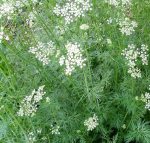 Cumin is a herbaceous annual native to the eastern Mediterranean east to India and has been known from ancient Egyptian times. Although there have been many claims about the medicinal value of cumin in modern times there does not appear to be significant evidence for health benefits and it is grown primarily for the culinary value of its seeds that are used extensively in Mexican and Indian cuisine. The plants are well branched and grow 12-20″” tall at a rapid rate. The leaves are 2-4″ long and pinnate or bipinnate with feathery leaflets. In summer small white or pink flowers are carried in compound umbels of 5-7 umbelletes and give way to fruits that ripen in late summer to early fall. Photo Credit: Wikimedia
Cumin is a herbaceous annual native to the eastern Mediterranean east to India and has been known from ancient Egyptian times. Although there have been many claims about the medicinal value of cumin in modern times there does not appear to be significant evidence for health benefits and it is grown primarily for the culinary value of its seeds that are used extensively in Mexican and Indian cuisine. The plants are well branched and grow 12-20″” tall at a rapid rate. The leaves are 2-4″ long and pinnate or bipinnate with feathery leaflets. In summer small white or pink flowers are carried in compound umbels of 5-7 umbelletes and give way to fruits that ripen in late summer to early fall. Photo Credit: Wikimedia
Isaiah 28. Cumin is used in a parable to teach that all knowledge ultimately comes from God.
25 When he has leveled the surface, does he not sow caraway and scatter cumin? Does he not plant wheat in its place,barley in its plot,and spelt in its field?
27 Caraway is not threshed with a sledge, nor is the wheel of a cart rolled over cumin; caraway is beaten out with a rod, and cumin with a stick.
Mathew 23.23 The passage is part of an address by Jesus to the crowd and his disciples. He is using the tithing of three herbs by the religious leaders as an example of how they observe the rules about little things (tithing herbs) while ignoring important matters. It is not mentioned in a parallel passage, Luke 11.42.
“Woe to you, teachers of the law and Pharisees, you hypocrites! You give a tenth of your spices—mint, dill and cumin. But you have neglected the more important matters of the law—justice, mercy and faithfulness. You should have practiced the latter, without neglecting the former.
Cumin likes full sun and average, moderately moist, well drained soil. It is susceptable to damage by aphids, wilt, blight, powdery mildew, and root rot and is best propagated by seed.
The genus name, Cuminum, comes from the Greek name for the plant, κύμινον.
-
25 When he has leveled the surface, does he not sow caraway and scatter cumin? Does he not plant wheat in its place,barley in its plot,and spelt in its field?
-
27 Caraway is not threshed with a sledge, nor is the wheel of a cart rolled over cumin; caraway is beaten out with a rod, and cumin with a stick.
-
23 “Woe to you, teachers of the law and Pharisees, you hypocrites! You give a tenth of your spices—mint, dill and cumin. But you have neglected the more important matters of the law—justice, mercy and faithfulness. You should have practiced the latter, without neglecting the former.